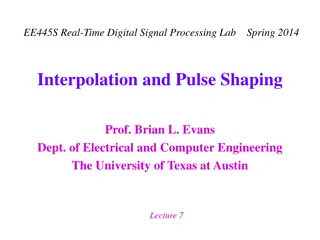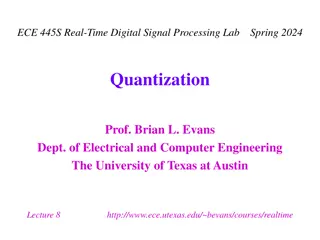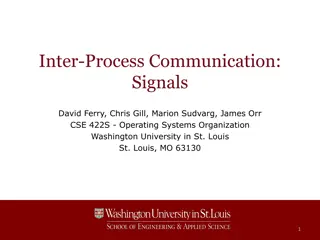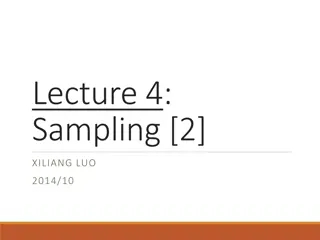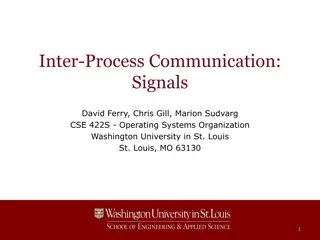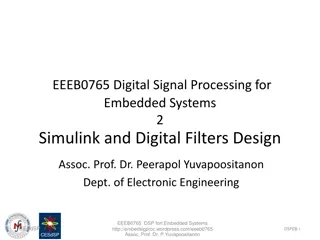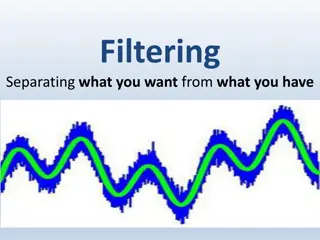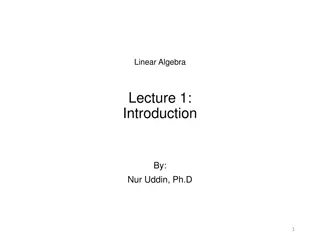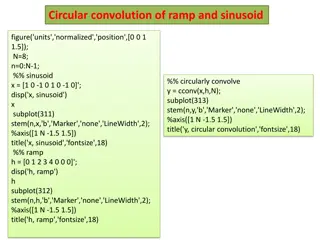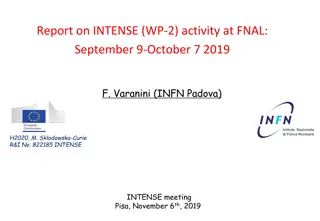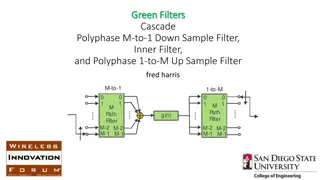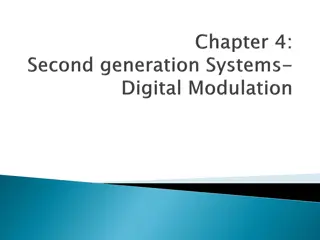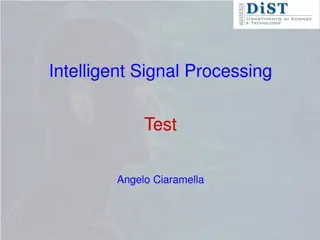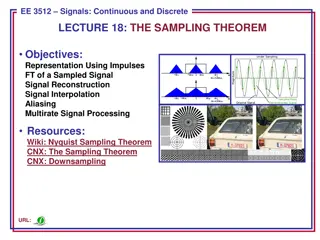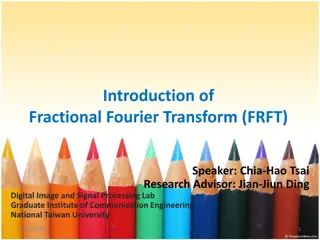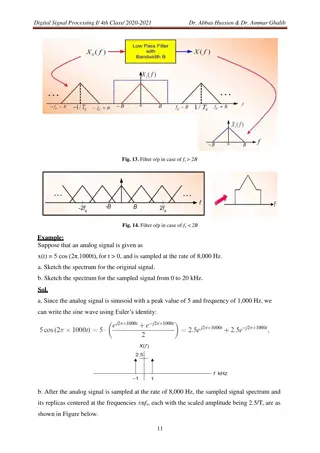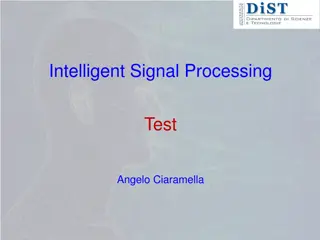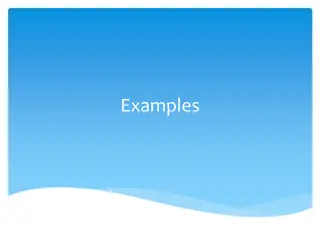Interpolation and Pulse Shaping in Real-Time Digital Signal Processing
Discrete-to-continuous conversion, interpolation, pulse shaping techniques, and data conversion in real-time digital signal processing are discussed in this content. Topics include types of pulse shapes, sampling, continuous signal approximation, interpolation methods, and data conversion processes
5 views • 14 slides
Real-Time Digital Signal Processing Lab: Quantization and Resolution Overview
Explore quantization and resolution techniques in real-time digital signal processing. Topics include quantization error analysis, total harmonic distortion, noise immunity in communication systems, human sensory resolution, analog-to-digital conversion, and uniform amplitude quantization. Dive into
7 views • 19 slides
Linear Discrimination for Classification
Linear discrimination is a method for classifying data where examples from one class are separable from others. It involves using linear models or high-order functions like quadratic to map inputs to class separable spaces. This approach can be further categorized as class-based or boundary-based, e
4 views • 37 slides
Linear Reservoir Baseflow Method
The linear reservoir baseflow method utilizes linear reservoirs to simulate the movement of water infiltrated into the soil. This method models water movement from the land surface to the stream network by integrating a linear relationship between storage and discharge. Users can select from one, tw
0 views • 11 slides
Linear Transformations and Matrices in Mathematics
Linear transformations play a crucial role in the study of vector spaces and matrices. They involve mapping vectors from one space to another while maintaining certain properties. This summary covers the introduction to linear transformations, the kernel and range of a transformation, matrices for l
2 views • 85 slides
Inter-Process Communication Signals in Operating Systems
Signals in inter-process communication are asynchronous notifications delivered to specific processes, allowing event-based programming. Processes can handle signal delivery by ignoring it, terminating, or invoking a signal handler. Signal handlers can be written in two ways - one handler for many s
0 views • 21 slides
Overview of Digital Signal Processing (DSP) Systems and Implementations
Recent advancements in digital computers have paved the way for Digital Signal Processing (DSP). The DSP system involves bandlimiting, A/D conversion, DSP processing, D/A conversion, and smoothing filtering. This system enables the conversion of analog signals to digital, processing using digital co
2 views • 24 slides
Mastering the Art of Introducing Quotes with Signal Phrases
Understanding the importance of signal phrases in academic writing. Signal phrases provide context, establish credibility of sources, and prevent dropped quotes. Learn the key elements required for an effective signal phrase and how to structure them using different formulas. Enhance your writing by
2 views • 16 slides
Advancements in Signal Processing for ProtoDUNE Experiment
The team, including Xin Qian, Chao Zhang, and Brett Viren from BNL, leverages past experience in MicroBooNE to outline a comprehensive work plan for signal processing in ProtoDUNE. Their focus includes managing excess noise, addressing non-functional channels, and evolving signal processing techniqu
2 views • 23 slides
Kingwood Traffic Signals Overview and Updates
Traffic operations in Kingwood, managed by Johana E. Clark, P.E., include signal system improvements and updates. Recent changes involve signal removal studies, new signal installations, and upgrades at key intersections to enhance traffic flow and safety. The system's capacity and daily traffic vol
1 views • 11 slides
Sampling and Signal Processing Fundamentals
Sampling plays a crucial role in converting continuous-time signals into discrete-time signals for processing. This lecture covers periodic sampling, ideal sampling, Fourier transforms, Nyquist-Shannon sampling, and the processing of band-limited signals. It delves into the relationship between peri
1 views • 60 slides
Linear Dependent and Independent Vectors
In linear algebra, when exploring systems of linear equations and vector sets, it is crucial to distinguish between linear dependent and independent vectors. Linear dependence occurs when one vector can be expressed as a combination of others, leading to various solutions or lack thereof in the give
1 views • 20 slides
Carnegie Mellon Algebraic Signal Processing Theory Overview
Carnegie Mellon University is at the forefront of Algebraic Signal Processing Theory, focusing on linear signal processing in the discrete domain. Their research covers concepts such as z-transform, C-transform, Fourier transform, and various signal models and filters. The key concept lies in the al
2 views • 40 slides
Converting Left Linear Grammar to Right Linear Grammar
Learn about linear grammars, left linear grammars, and right linear grammars. Discover why left linear grammars are considered complex and how right linear grammars offer a simpler solution. Explore the process of converting a left linear grammar to a right linear grammar using a specific algorithm.
1 views • 44 slides
Centre of Excellence in Signal Processing Activities and Progress Report
Broad areas of signal processing activities at the Centre of Excellence in Signal Processing include audio, speech, language, medical image processing, computer vision, wireless communications, and machine learning. The center focuses on addressing various challenges in audio/speech recognition, emo
0 views • 17 slides
Adapting Linear Hashing for Flash Memory Constrained Embedded Devices
This research explores the adaptation of linear hashing for improved data handling on flash memory-constrained embedded devices. Motivated by the increasing data collection by IoT devices, the study focuses on implementing database structures like a linear hash table for efficient data processing. T
0 views • 67 slides
Inter-Process Communication Signals in Operating Systems
Signals in operating systems play a critical role in facilitating asynchronous notifications between processes. They allow for event-based programming and are conceptually similar to hardware interrupts and exceptions. Processes can handle signal delivery by ignoring it, terminating, or invoking a s
0 views • 24 slides
Linear and Nonlinear Functions in Mathematics
Explore the concepts of linear and nonlinear functions in mathematics through identifying linear and nonlinear functions from graphs, understanding the characteristics of linear functions, and identifying linear functions from tables. Learn about the constant rate of change, slope, and how to determ
0 views • 49 slides
Fast Fourier Transform (FFT) in Signal Processing
Fast Fourier Transform (FFT) is a powerful algorithm used in signal processing to efficiently calculate the Discrete Fourier Transform (DFT). This advanced technique leverages symmetry and periodicity properties to reduce computational complexity, making it a key tool in digital signal analysis. By
0 views • 14 slides
Digital Signal Processing for Embedded Systems: Simulink and Digital Filters Design
Explore the world of Digital Signal Processing for Embedded Systems with an emphasis on Simulink and Digital Filters design. Discover tools, examples of Simulink models, basics of noise cancellation, and applications of active noise cancellation headphones. Dive into the realm of Embedded Systems th
0 views • 38 slides
Exploring the Power of Filtering in Signal Processing
Delve into the world of signal processing and filtering as a means of separating desired information from noise. Explore the role of digital filters in processing images and signals. Discover how filtering can achieve noise cancellation in headphones, clean up noisy images, and understand the import
0 views • 29 slides
Introduction to Linear Algebra: Syllabus, Examples, and Solutions
Delve into the fundamentals of linear algebra through a series of lectures and examples by Nur Uddin, Ph.D. Explore the application of linear algebra in daily life scenarios, solving linear equations and systems, matrices multiplication, and more. Understand the concept of linear systems, solutions,
1 views • 24 slides
Circular Convolution of Ramp and Sinusoid
Circular convolution of a ramp signal and a sinusoid, followed by convolving a rectangular pulse with itself for exploring convolution techniques. The process involves visualizing signal convolutions, understanding how zero-padding affects plotting clarity, and using convolution for denoising a piec
0 views • 4 slides
Advanced Signal Processing for ICARUS@SBN: Achievements and Collaborations
In-depth analysis of intense activities at FNAL focusing on wire signal processing, SBN analysis, and tools development for ICARUS@SBN. Highlights include noise characterization, hit-finding performances, detector systematics, and preliminary measurements of ICARUS noise level and spectrum. Detailed
0 views • 5 slides
Impulse Response and Polyphase Filters in Signal Processing
Discover the application of impulse response and polyphase filters in signal processing, including M-to-1 and 1-to-M processing, narrow bandwidth filtering, cascade filters, and prototype filters. Explore the design considerations, frequency responses, and spectral masks for optimal signal manipulat
0 views • 30 slides
Understanding Signal Transmission and Systems
Explore the significance of carriers, signal power, bandwidth, Fourier Transform, Parseval's Theorem, and input-output systems in the context of signal processing and communication. Learn about linear vs. non-linear systems and the fundamental principles governing signal analysis and transmission.
0 views • 16 slides
Understanding Communication Engineering: Modulation, Fourier Transform, and Signal Frequency Shifting
Dive into the world of communication engineering, exploring topics like modulation, Fourier transform, baseband signal, carrier communication, and more. Discover the importance of modulation in signal processing and communication systems. Learn about baseband and carrier communication techniques alo
0 views • 30 slides
Understanding Analog to Digital Conversion in Signal Processing
Dive into the concept of analog to digital conversion in signal processing, covering topics such as PCM, Nyquist law, quantization, companding, digital encoding, and data rates. Learn how analog signals are converted to digital pulses and the techniques involved in signal reconstruction. Explore the
0 views • 27 slides
Understanding Analog and Digital Signal Processing Systems
Explore the differences between analog and digital signal processing systems, highlighting their components, limitations, and applications. Learn how analog components and digital techniques shape signal processing in today's technology-driven world.
0 views • 4 slides
Intelligent Signal Processing Test by Angelo Ciaramella
Explore the main phases of Analog to Digital Conversion and Pulse Code Modulation in the realm of Intelligent Signal Processing. Dive into concepts like sampling theorem and more essential aspects of signal processing.
0 views • 18 slides
Sampling Theorem in Signal Processing: Representation and Reconstruction
Learn about the Sampling Theorem in signal processing, which explains how bandlimited continuous-time signals can be represented as discrete-time signals without losing information. Understand signal reconstruction, interpolation, aliasing, and multirate signal processing concepts. Explore the Fouri
0 views • 13 slides
Understanding Fractional Fourier Transform (FRFT) and Linear Canonical Transform (LCT) in Signal Processing
Explore the concepts of Fractional Fourier Transform (FRFT) and Linear Canonical Transform (LCT) in digital image and signal processing. Learn about their properties, definitions, implementations, and applications in time-frequency plane rotations. Discover the relationships between Wigner Distribut
0 views • 56 slides
Receiver Signal Processing Essentials
Explore key concepts in receiver signal processing, including sensitivity, transceivers, signal frequency conversion, and signal discrimination capabilities.
0 views • 22 slides
Understanding Advanced Concepts in Signal Processing
Explore the in-depth concepts of signal processing in CS-111, covering analog vs. digital signals, linear system properties, convolution algorithms, edge detection methods, spectral analysis, non-linear filters, histogram analysis, and more.
0 views • 19 slides
Understanding Spectrum Analysis and Signal Reconstruction in Digital Signal Processing
Explore the concepts of spectrum analysis, signal sampling, aliasing, and signal reconstruction in digital signal processing. Learn about the Nyquist theorem, lowpass filters, and handling spectral distortion. Ideal for students and enthusiasts of signal processing.
0 views • 4 slides
Signal Processing Insights: Fast Fourier Transform and Intelligent Analyses
Discover the significance of Fast Fourier Transform in signal processing, its history, and implementation in Intelligent Signal Processing (ISP) Verification tests. Learn about DFT, decimation techniques, analysis, and synthesis processes for efficient signal analysis and manipulation.
0 views • 17 slides
Understanding Signal Strength and Attenuation in Decibels
Explore the concept of measuring signal strength and attenuation using decibels. Learn about the unit of decibel, calculation formulas, signal amplification, and why engineers use decibels in signal measurements. Dive into examples and understand how decibel values can be added or subtracted to meas
0 views • 10 slides
Real-Time Digital Signal Processing Laboratory Course Overview
Explore the course objectives, design flow, signal processing building blocks, and signal quality measures in the context of real-time digital signal processing. Gain insights into tradeoffs in signal quality versus runtime implementation complexity, receiver design methods, communication systems, a
0 views • 24 slides
Understanding Complex Quadrature Signals in Biomedical Signal Processing
Explore the interdisciplinary nature of biomedical signal processing, delve into ultrasound applications, and discover the capabilities of digital signal processing through processing complex quadrature signals. Learn about complex signals, quadrature signals, Doppler effect, ultrasound, demodulator
0 views • 57 slides
Signal and Image Processing Job Descriptions for New Hires
Explore job descriptions for new hires in Signal and Image Processing. The roles involve developing algorithms for target detection and improving signal processing techniques using various sensor data. Ideal candidates should have skills in MATLAB, C/C++, image processing, pattern recognition, and m
0 views • 8 slides
